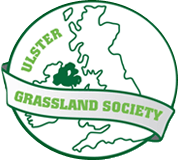Event Details
- Date: 20 Apr 2016
- Venue: Omagh Dairy Farm
Large turnout at UGS spring visit to Omagh – regardless of weather!
The wintry conditions of hail showers did not deter a large turnout of farmers at the UGS spring farm walk at Omagh. In welcoming the UGS, Cormac Cunningham outlined the development of the leased farm at Crevenagh and emphasized that the success of a lease depends on the landlords, quality of the land, availability of labour and selection of the most suitable type of stock.
Visitors saw the herd of NZ Fr/Jersey cows out grazing in a paddock system with areas selected on the basis of grass cover and ground conditions. Farm Manager Cathal McAlear emphasized the importance of cow type and using EBI bulls to raise milk protein levels and improve fertility. The spring calving herd is currently achieving M+18 litres/cow from grass, with 4kgs/hd of a 14% protein nut fed flat rate. Cathal told those attending “Meal levels will be cut to 2kg/cow/day in the next few days as grass analysis shows excellent quality at 24% protein and 12.4 ME. This will support M+24 l/cow. The herd is currently averaging 27 l/cow/day and I’m keeping a close eye on milk protein levels as this indicates if the cows are receiving enough energy”.
The importance of soil fertility was highlighted by Dr Stan Lalor of Grassland AGRO who had dug two soil profiles at differing points in a field with a significant slope. Stan told UGS members “Although the soils are broadly formed from the same material, they are different in how they behave and grow grass, and this will impact on how they should be managed. The average Ph of the total field when sampled was 6.1, but the flat area at the bottom had a higher pH and that on the slope was lower. There is also a difference in P and K levels between the two areas” The issues of run-off, compaction and aeration were discussed and Stan advised that any mechanical intervention should be targeted for the specific problem being faced.
The final stop of the visit involved Jason McMinn from Farmgate Consultancy who discussed the performance of the spring calving system on the host farm, and compared it to the higher yielding herd managed by the Cunningham family on another farm.
FARM DETAILS (Crevenagh Rd)
- Area farmed 56 ha at Crevenagh Road – leased since 2012 and all in grassland
- Stock: 140 dairy cows (NZ Friesian X); Compact spring calving pattern
- 40 replacement heifers have been reared each year 25 heifers will be reared annually in future
- Bull calves sold within 10-14 days
- Labour: Farm manager + 1 fulltime
RECENT DEVELOPMENTS
- 75 acres reseeded since 2012
- Laneways resurfaced and come new tracks put in 2012 and farm fenced for 24-36hr grazing’s
- 20 unit Herringbone Dairymaster milking parlour installed in December 2013 and cubicle house erected in 2013
GRASSLAND
- 75 acres reseeded since 2012 with aim of producing swards yielding 14 t DM/ha
- Drumbo, Aberchoice and AbergainVarieties used in a full ploughing reseed
- 2-4t lime applied at reseeding depending on pH and most paddocks now have a Ph >6.0
- Sub soiling and spiking carried out to improve drainage and aeration – more needed!
NUTRIENT MANAGEMENT
- All fields have been soil sampled with a fertiliser/liming plan in place
- Majority of paddocks have low Potassium (Index 2)
- Slurry application contracted out using an umbilical system
Silage
- 1st cut – 2000 gls/acre + 70 units Nitrogen, 15 units P, 30 units K
- 2nd cut – same as 1st cut but no K
Grazing
- Slurry + CAN (+Sulphur).
- Slurry after 1st grazing if possible.
CURRENT PERFORMANCE
Milk Yield (herd average) – 6000 litres/cow (rolling ave)
Milk from Forage – 3500 litres/cow
Stocking rate – 2.5 CE/ha
Milk Composition
Butterfat – 4.26 %
Protein – 3.47 %
Milk solids – 478 kg/cow/yr
SCC – 100
Concentrate fed – 1.0 tonnes/cow (0.17 kg/ litre)
Milk Sold To Strathroy Dairy
Replacement rate – 18 %
Organic N Loading – < 170 kgN/ha
SILAGE
Two cuts of silage made by contractor with total of 140 acres needed to meet winter feed requirements. 50% of silage bought in owing to stocking rate
GRAZING
- Approx 110 acres in grazing platform. Remaining 30 acres down road can be grazed at shoulders
- Currently 45 hectares allocated to the herd to give a stocking rate of 3.3 cows/ha (1.35 cows/acre).
- Grazing by day from 28th February and by night from 10th March.
- Paddock grazing system used with areas selected on basis of grass cover and ground conditions.
- Target grazing cover is 1900 kgDM/ha grazed down to 1550 kgDM/ha. Agrinet grazing program used
- Make bales of poor quality paddocks when possible
- Pre mow paddocks if quality deteriorating
- Back fence when conditions deteriorate.
- Good laneway system and drinking points.
MANAGEMENT AT GRASS
All concentrates (14% protein) allocated through milking parlour. Cows get 2kg/head and cows milking >35litres get an additional 0.4kgs/litre above base of 35 litres
HERD MANAGEMENT
- Compact calving pattern with calving starting on 10th Feb and finishing on 15th April
- Breeding starts on 1st May for 12 weeks – AI for 6 weeks, then Hereford bull.
- Fertility performance – Empty rate 5%
- Focus on EBI when selecting bulls; high fertility and components, particularly protein %
- First lactation cows dried off for minimum of 12 weeks irrespective of yield in autumn.
- Older cows have a 60 day dry period and cows in poorer condition get a longer dry period.
- Cows not in calf after breeding period are sold in September
- Vaccination programme – BVD, IBR and Lepto
WINTER FEEDING
- Herd housed early November depending on conditions.
- Dry cows get silage and dry cow minerals over winter







